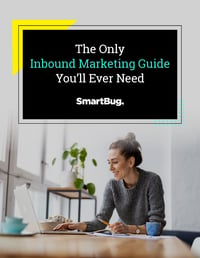
7 Steps to Plan a Successful Event: Lessons Learned from INBOUND '22
October 10, 2022
After two years of virtual-only events, 2022 was the year of the comeback for in-person events. HubSpot’s annual INBOUND conference was one of those to invite in-person attendees back.
During the last two years, INBOUND was completely virtual, which only increased the excitement around returning in-person this year. As HubSpot’s Partner of the Year in both 2020 and 2021, we planned to return with the biggest presence we’ve ever had as a company.
SmartBug was an INBOUND conference sponsor for the fifth year in 2022. This year, we planned and executed two different events affiliated with HubSpot and three off-site event experiences for INBOUNDers. In addition to planning for both our in-person and virtual booth presences, we strategized a full-day restaurant buyout, happy hour, and private dinner event. Across these five different events, we wanted consistent branding and an experience that both in-person and virtual INBOUND 2022 attendees could enjoy.
Pulling off all these events took six months of behind-the-scenes work. That sounds intense, but all big plans have to start somewhere. Let’s walk through the process together.
Step 1: Define your event purpose.
Before any event, you need to identify why you’re going. Are you attending as a sponsor? Are you attending as just an attendee to vet the event for your company? Are you the event host? Knowing where your position is and your purpose for attending will lead you to defining your budget and developing SMART goals (more on that below).
Step 2: Outline your budget.
Next, it’s time to outline your budget. It’s easy to overspend on events, and a budget provides a roadmap of what is possible to include at your event—and what might not be. Even when a budget is set, though, you can still dream “BIG.”
For INBOUND 2022, we wanted to host an event off-site. This put additional spend into the budget that we did not have room for. Do you think we just scratched the idea? No! We pathed a way through sponsorships. We involved our martech partners and enabled them to host the event WITH us. In turn, we were able to host three events off-site to attract and engage prospects and to delight our current employees and clients.
Pro tip: Be sure to receive executive buy-in, and manage your budget throughout each purchase and phase of the event planning. This will help you stay accountable and on track.
Step 3: Create SMART Goals.
Once your purpose and budget are defined, your next step is developing SMART goals, which are:
- Specific
- Measurable
- Attainable
- Relevant
- Time-based
When creating these goals, you don’t want to take a shot in the dark. It’s important to look back on what was achieved in the past in order to appropriately define these goals. For example, if you generated 100 leads from a previous event, maybe you increase your goal to 125. If you don’t look back, it’s challenging to set goals to help you grow moving forward.
Our goals for INBOUND 2022 were:
- Generate qualified booth visitors, both in-person and virtual, during Sept. 6-9, 2022. From there, convert at least 30 percent or more into marketing qualified leads (MQLs) within the next two months.
- Generate pre-show meetings booked before Sept. 5.
- Drive registrants to the Intelligent Inbound® Lounge by Sept. 7, and expect 30 percent of registrants to show up between both event days.
Step 4: Plan a marketing campaign.
At SmartBug, we use the Intelligent Inbound® marketing approach. This is a proven integrated marketing approach that includes digital campaigns, lead generation, content and SEO strategy, conversion optimization, PR, and paid media to deliver predictable results. We tapped into these elements of inbound marketing to create our marketing campaign for INBOUND 2022.
If you don’t know where to start, check out HubSpot’s inbound marketing methodology: attract, engage, and delight.
Step 5: Organize your execution timeline strategy.
Once you know your inbound marketing strategy, it’s time to create a project timeline. Sometimes this can be the hardest part of the planning process. Below are a few tips to help you create and manage your timeline.
Use a task management system.
A task management system is crucial for keeping you and your team organized. There are various platforms—including Trello, Teamwork, and Asana—designed to provide you with a template to manage your project deliverables.
Bucket your biggest topics of need and define tasks beneath each one.
For me, procrastination happens when I look at the mountain of tasks ahead of me and then have no idea where to begin. When planning for an event, I’ve found that the easiest way to fight the urge to procrastinate is to group tasks by key topics.
For INBOUND 2022, we created the following groups: pre-event tasks, in-person booth logistics, lead generation marketing campaign, SmartBug lounge, attending logistics, partner programs, and post-show event plan. This high-level overview of a few of our biggest topics helped us outline specific tasks in order to then organize and manage the workload.

Set deadlines.
Without any deadlines, you are setting yourself up for failure. Always start with the event date and work backward. Deadlines can be modified as needed throughout the planning process, but be cautious of pushing certain dates out because deadlines are milestones to help you cross the finish line on time.
Begin by setting deadlines for the larger tasks and work your way down to the smaller tasks. For INBOUND 2022, we established the landing page as one deadline and then worked our way down, assigning tasks and deadlines to help us reach that date. Don’t start with the tedious assignments. Begin with your biggest milestones and work from there.
Pro tip: On time and on budget are the biggest pieces of event planning. Sometimes deadlines will inevitably need to be moved, but the more you can avoid this, the better.
Step 6: Give ownership of specific tasks to your team.
Let it still be said—teamwork makes the dream work. You are only one person. Don’t let the weight of the event fall only on your shoulders. You can maximize time and effort by giving specific tasks to other team members. For example, if you need help with graphic design elements, hand those off to someone on the creative team; if you need help with content, ask your content marketer for help. Team collaboration will strengthen your event marketing efforts and alleviate work for yourself.
Step 7: Schedule a cadence of meetings.
Communication is crucial for successful execution. It’s easy to miscommunicate or misinterpret instructions, and one way to help combat this is with meetings. In the beginning of event planning, when you are months away from the event date, you will not need as many meetings as you will the month of.
For INBOUND 2022, we began meeting six months in advance. However, there was no set meeting cadence—yet. We started with one-off strategy calls and theme-building activities to lay the groundwork. Once we hit three months out, we began meeting once per week with team members who were heavily involved in event planning. This led to meeting twice a week or more depending on who we needed to meet with, such as the executive team or the creative team, to make sure all deliverables were being appropriately managed. Needless to say, the momentum grows and the cadence of meetings increases the closer to the event you get.
Outside of the meetings, to promote successful team communication, we used Slack as a channel to work through specific tasks. I created a 20-page document for the SmartBug team to have as a cheat sheet for all the logistics each individual who was attending the conference in-person needed to know. We kept the lines of communication between us and the executive team open and made sure everyone was on the same page.
Put your events on the path to success.
Ready to plan your next event? This seven-step process is your guide to lead you on a path to a successful event launch.
To sum it all up:
- Define your event purpose.
- Outline your budget.
- Create SMART goals.
- Plan a marketing campaign. Get your free inbound marketing guide here.
- Organize your execution timeline strategy.
- Give ownership of specific tasks to your team.
- Schedule a cadence of meetings.
Lastly, check out the events SmartBug will be attending this year. Happy planning!

About the author
Brooke Master was formerly the Content Marketing Coordinator at SmartBug Media. Brooke played a key part in executing multi-channel campaigns and programs at scale to increase inbound customer acquisition and engagement, and grow pipeline generation. Her passion as a woman in business is not only in marketing avenues but also for ministries and churches worldwide. Read more articles by Brooke Master.








